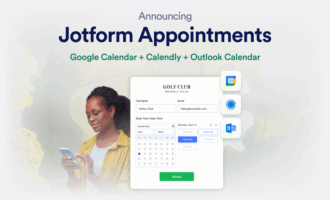Whether you’re a dentist, fitness trainer, or photographer, you probably agree that one of the most annoying aspects of your job is dealing with administrative tasks like scheduling. Your skills and talents are better suited for helping your clients, so you need a way to let others easily book time with you.
This is where online booking systems come in. These systems save time for both you and your clients, as there’s no need for back-and-forth emails and calls. Instead, you can simply share your schedule, and they can book appointments at their convenience.
But how do you create an effective online booking system? We’ll answer that below, but first, let’s look at a few features and capabilities to consider when choosing an online booking system.
What is an online booking system?
An online booking system is a tool that lets your customers book appointments or services straight from your website or app — no phone calls or back-and-forth emails required. It gives people the freedom to schedule at their convenience, even outside your business hours.
With features like interactive calendars, payment processing, automatic reminders, and 24-7 access, these systems take the hassle out of scheduling. They help cut down on no-shows, save time on manual admin work, and create a smoother experience for everyone.
Whether you’re a dentist, fitness coach, pet groomer, or run any kind of appointment-based service, an online booking system keeps your schedule organized and your customers happy.
What to look for in a booking system?
1. Around-the-clock booking access
“Your online booking system should be able to capture as many leads as possible,” says Julia Douglas at scheduling software provider Setmore. Just because your business is closed for the day doesn’t mean your scheduler should be too.
Pro Tip
Capture bookings 24/7 with an AI phone answering system, ensuring your business never misses an opportunity outside office hours.
“Your customers should be able to select their own booking time from a preset range of times,” she says, “without needing to call your business and leave a voicemail.”
2. Appointment reminders
Douglas says appointment reminders are another important feature to consider, as they reduce the number of no-shows and unnecessary administrative time for follow-up contacts with those customers. “It’s beneficial if the booking solution offers email or even SMS appointment reminders,” she says. “It will save customers time and you money.”
3. Multiple bookings
Talha Waseem, a tech content editor at software development outsourcing company InvoZone, says a useful feature is the ability to do multiple bookings at the same time.
“This is a key feature in healthcare, as patients may need to book with multiple doctors or departments around the same time,” he says. “The complexity of this feature may knock a lot of solutions out of the running, but it’s something to consider if it makes sense for your business.”
4. Payment processing
If your business model requires clients to pay before they can secure a time slot, payment processing is an essential feature to look for in an online booking system. For example, you may be a fitness instructor who doesn’t block out time on your schedule unless you receive full payment or at least a 50 percent deposit.
Whatever online booking system you choose will of course depend on your unique needs. Tim Green, head of partnerships and marketing at the fitness business management service TeamUp, explains that the most important consideration is how your clients and potential clients will interact with the solution.
“There are hundreds of solutions available on the market,” he says. “But the solution offering the best value will be the one that fits as many of your needs as possible for the lowest price.”
For example, Green notes that if you offer one-on-one appointments, you’ll likely benefit most from reminders and calendar links. If you offer group sessions, such as fitness classes at a gym, then integrated prepayments and easy rescheduling features might top your list of must-haves. “In any case, thoroughly review your options to ensure you make the right choice,” he says.
How to create an online booking system
Here are a few simple steps you can follow to create an online booking system that works for your business:
Step 1: Clearly identify your needs and goals
Before you start searching for an online booking system, clearly define your objectives. Consider the following questions:
- What type of appointments or reservations will you be managing (medical consultations, fitness classes, salon appointments, etc.)?
- Do you require online payment options?
- Will your system need integration with existing software like Google Calendar, CRM, or email marketing tools?
- Do you want automated reminders or follow-ups for customers?
- How many users or staff members will be accessing the system?
Answering these questions clearly helps pinpoint essential features and capabilities your system must have.
Step 2: Market research and comparison
Once you’ve identified your goals, research different booking solutions available. Consider the following factors:
- Features and functionality: Identify solutions that directly align with your identified needs.
- Pricing: Ensure that the solution fits within your budget. Compare monthly fees, transaction costs, and hidden charges.
- User experience: Evaluate systems based on ease of use from both the customer and administrative perspectives.
- Integration options: Check whether the booking software integrates smoothly with tools you’re already using.
- Scalability: Ensure that the system can accommodate your business growth over time.
Create a shortlist of the top 3-5 platforms based on these criteria.
Step 3: Implement and configure your chosen system
Once you’ve selected the ideal solution:
- Sign-up or purchase: Subscribe to your chosen booking service.
- Customize settings: Configure the system according to your requirements (e.g., set available hours, define booking intervals, and customize automated notifications).
- Integrations: Connect the system with other business tools (like payment gateways, CRM, and calendars).
- Training: Provide staff with adequate training to ensure efficient use and smooth operation.
Be prepared that some systems might take considerable setup time, especially if you require extensive customization.
Step 4: Test and refine the system
Before launching:
- Conduct thorough testing by simulating various booking scenarios.
- Ensure automated processes such as payment processing, confirmations, reminders, and integrations function properly.
- Gather initial feedback from staff who will manage bookings regularly.
Address any issues identified during testing to avoid problems upon launch.
Step 5: Launch and monitor your booking system
Officially launch your online booking system and communicate clearly to your clients about the new system:
- Use email announcements, social media updates, or signage at your physical location.
- Offer brief guidelines or tutorials if necessary.
Monitor closely during the initial weeks to quickly handle any unforeseen issues.
Step 6: Regularly reassess and optimize
Ongoing evaluation is essential to ensure continued effectiveness:
- Monitor customer satisfaction and collect feedback regularly.
- Analyze booking data and performance reports to identify trends and bottlenecks.
- Stay informed about updates from the booking software provider to leverage new features or enhancements.
- Adjust system configurations as your business needs evolve.
Periodic reassessment helps maintain an optimal system aligned with your business’s growth trajectory.
Jotform, an easy-to-use form builder, addresses your booking needs through its appointment feature. You can enable bookings for your dentist office, fitness business, photography studio, or other business by starting with one of our many form templates, then adding the appointment field. Here’s how to do that. Try a booking form today.













































Send Comment: